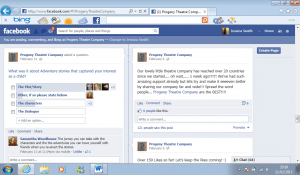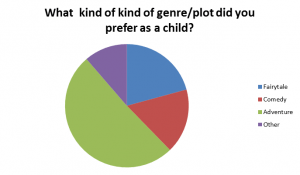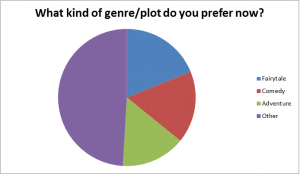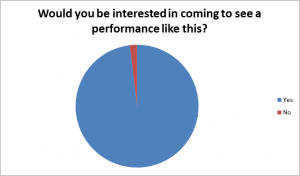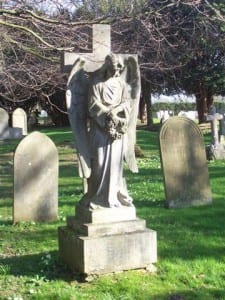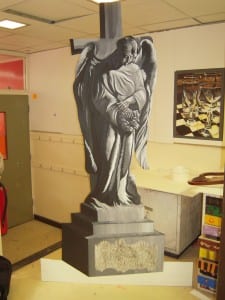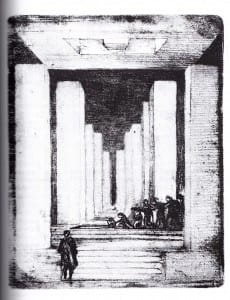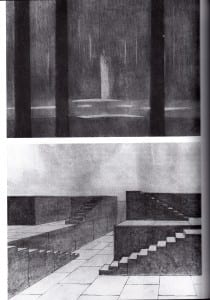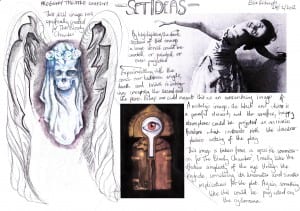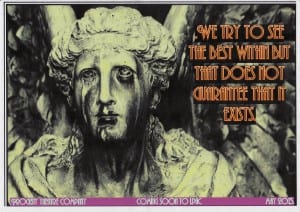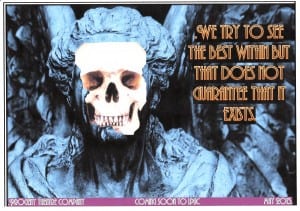Market Research
As soon as we had our manifesto written, as a group, we had a better understanding of what direction we wanted to take our theatre company. As Progeny Theatre Company we wanted to take well known children’s stories and adapt them into adult’s theatre. We decided that our first step should be to go out into the public and carry out market research. Although we did not know our specific target audience at the time, our initial idea was to make theatre for adults so we targeted eighteen years and over. We thought it was of importance to find out what Children’s stories stand out to adults now and what stories they remember from their childhood. We did this to compare what stories children have nowadays and whether they were the similar to what the participants remembered. From our research we gathered that although newer stories were mentioned (mainly Disney), Little Red Riding Hood and Snow White were also popular. The main reason for this was due to reading these stories to the younger generation. We also wanted to discover why these stories stood out to our target audience so that we could understand the popularity of these stories which could help us in framing our own adaptations. We had many different responses to this question; however the main reason was simply because that is what they read as children. We also wanted to find out what genre they preferred as children and what genre they prefer now. We did this to compare the two and see if their preferences had changed as they grew older. We actually discovered that a lot of people who liked fairy-tales or adventure as children preferred horrors as adults (this is shown in the other category). This is the best response that we could hope for as it fits with exactly what we are doing with our Theatre Company, as we are combining both genres. The top genre that people enjoyed as children was adventure; this sparked our curiosity and made us wonder why. So we created a poll on our Facebook page to find out why. The poll results were as follows:
The clear outcome was that people preferred the plot/story of adventures. However, we found Samantha Woodhouse’s response interesting, “The journey you can take with the characters and the adventures you can have yourself with friends when you re-enact the stories” (2013). We found this interesting due to the element of imagination involved within children’s stories as we are trying to recreate this for the adults. We also wanted to know if the public had ever noticed any underlying issues within children’s stories. The example that we used to explain it to them was The Ugly Duckling and how it could be argued that this story sends the message that being beautiful is of great importance and that if you are not beautiful then you will be bullied. Many people did not notice the underlying messages but a few people did. One response we received was “Yeah pretty much all fairy tales tend to have stereotypical things such as the ugly sisters and the roles of women are very set so they can be quite sexist. Oh and then there’s the stereotype of that beautiful princess’ are skinny with big eyes etc.” (Rebecca Walker, 2013). We found this quote suitable to our project. We feel that the fact that many people did not notice any underlying issues will be a benefit to our company as it shows that what we are doing is quite unique. We finally asked the public if they would be interested in seeing a performance like ours and we only received one no from all of the people we asked. The reason that he gave was simply because he did not enjoy going to the theatre.
We have collated all of the data into pie charts and tally charts/graphs so that we were able to visually see our results. They are as follows:
Question One.
| Hansel and Gretel |
5 |
| Snow White |
5 |
| The Gruffalo |
5 |
| Cinderella |
4 |
| Little Red Riding Hood |
4 |
| Beauty and the Beast |
3 |
| The Chronicles of Narnia |
3 |
| The Harry Potter Saga |
3 |
| The Ugly Duckling |
3 |
| Bambi |
2 |
| Goldilocks and the Three Bears |
2 |
| Peter Pan |
2 |
| The Hungry Caterpillar |
2 |
| The Tortoise and the Hare |
2 |
| The Twits |
2 |
| Alice in Wonderland |
1 |
| Basil the Great Mouse Detective |
1 |
| Bear on the Pond |
1 |
| Bill and Ben |
1 |
| Can’t You Sleep Little Bear? |
1 |
| Coraline |
1 |
| Diary of a Wimpy Kid |
1 |
| Disney Books |
1 |
| Dumbo |
1 |
| Fairytales |
1 |
| Finding Nemo |
1 |
| George’s Marvellous Medicine |
1 |
| Grimm Fairytales |
1 |
| Jack and Jill |
1 |
| Little Miss Muffet |
1 |
| Lord of the Flies |
1 |
| Mary Poppins |
1 |
| Moby Dick |
1 |
| Mr Men and Little Miss |
1 |
| Mrs Frisby |
1 |
| Of Mice and Men |
1 |
| Roald Dahl |
1 |
| Rowan on Rin |
1 |
| Sleeping Beauty |
1 |
| Tangled |
1 |
| The Beatrix Potter Books |
1 |
| The Boy Who Cried Wolf |
1 |
| The Hobbit |
1 |
| The Lady and the tramp |
1 |
| The Little Engine That Could |
1 |
| The Little House on the Prairie |
1 |
| The Princess and the Pea |
1 |
| The Rats of Niamh |
1 |
| The Secret Garden |
1 |
| The Tales of Paddington Bear |
1 |
| The Twilight Saga |
1 |
| Three Little Pigs |
1 |
| Treasure Island |
1 |
| Winnie the Pooh |
1 |
| Zanzibar |
1 |
Question Two.
| Little Red Riding Hood |
4 |
| The Very Hungry Caterpillar |
4 |
| The Tortoise and the Hare |
3 |
| The Ugly Duckling |
3 |
| Winnie the Pooh |
3 |
| Beauty and the Beast |
2 |
| Cinderella |
2 |
| Noddy |
2 |
| Snow White |
2 |
| The Chronicles of Narnia |
2 |
| The Hobbit |
2 |
| The Twits |
2 |
| The Famous Five |
2 |
| Adventure Book for Boys and Girls |
1 |
| Aladdin |
1 |
| Alice and wonderland |
1 |
| Basil, the Great Mouse Detective |
1 |
| The Beatrix Potter Books |
1 |
| Biff and Chip |
1 |
| Can’t You Sleep Little Bear |
1 |
| The Cat in the Hat |
1 |
| Charlie and the Chocolate Factory |
1 |
| Charlotte’s Web |
1 |
| Chip and Kipper |
1 |
| Disney |
1 |
| Finn McColl |
1 |
| George’s Marvellous Medicine |
1 |
| Goldilocks and the Three Bears |
1 |
| Goosebumps |
1 |
| Hansel and Gretel |
1 |
| The Harry Potter Saga |
1 |
| His Dark Matters Trilogy |
1 |
| Horrible Histories |
1 |
| Jack and Jill |
1 |
| Lord of the flies |
1 |
| Madame Doubtfire |
1 |
| My Family and Other Animals |
1 |
| The Chronicles of Narnia |
1 |
| Naughty Little Sister |
1 |
| Paddington Bear |
1 |
| Peter Pan |
1 |
| The Princess and the Pea |
1 |
| Roald Dahl |
1 |
| Rowan of Rin |
1 |
| Rumpelstiltskin |
1 |
| The Boy Who Cried Wolf |
1 |
| Grimm Fairytales |
1 |
| The Cloth of Dreams |
1 |
| The Famous Five |
1 |
| The Gruffalo |
1 |
| The Lady and the Tramp |
1 |
| The Land Before Time |
1 |
| The Lion King |
1 |
| The Little Engine That Could |
1 |
| The Philosophy Files |
1 |
| The Pig in the Pond |
1 |
| The Secret Garden |
1 |
| The Silver Sword |
1 |
| The Velveteen Rabbit |
1 |
| The Wizard of Oz |
1 |
| The Three Little Pigs |
1 |
| You’re Safe Now, Waterdog |
1 |
Question Four.
Fairytale 21% preferred
Comedy 17% preferred
Adventure 51% preferred
Other 11% preferred
Question Five.
Fairytale/Romance 19% preferred
Comedy 17% preferred
Adventure 15% preferred
other 49% preferred
Question Six.
Yes – 60%
No -40%
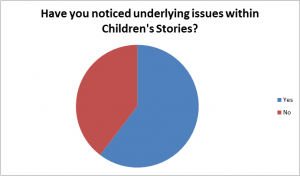
Question Seven.
Yes – 98%
No – 2%
Word Count – 1074
